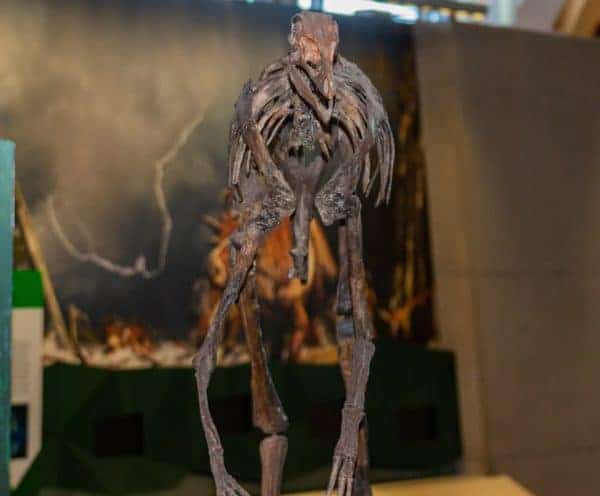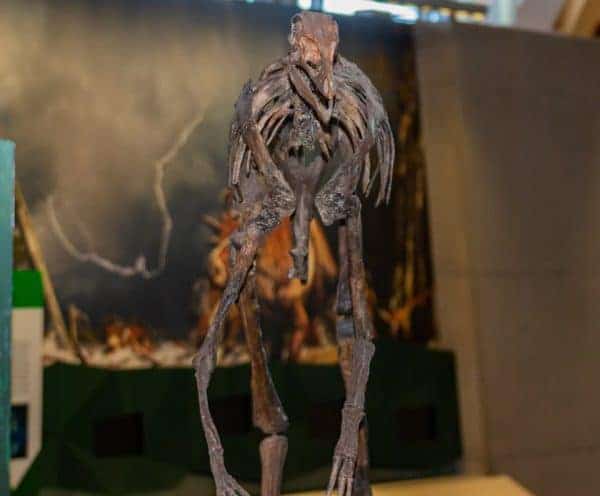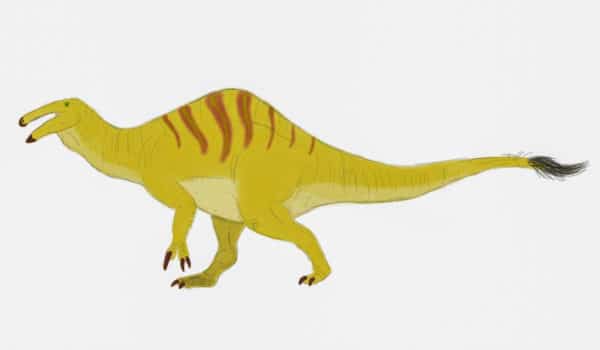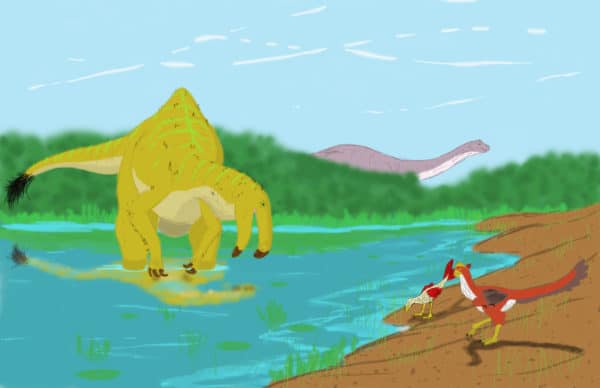
Dinosaurs have become so popular that it’s easy to forget just how weird they are as animals. Many were huge, and depending on the family some had long necks, plates, spikes, horns, frills, domed heads, and other such things. Some were the size of elephants but with heads the size of a horse’s. That isn’t to say that, in the big picture, dinosaurs are any less wacky than many animals around today. Whales, pangolins, turtles, and most birds are all truly bizarre creatures, but (likely aside from pangolins) we’re pretty used to them. Mesozoic dinosaurs are unfamiliar, and so by our standards they’re pretty weird, but some are less familiar than others. One case I’d like to highlight in this article is the ‘terrible hand’ of Mongolia, Deinocheirus.
In 1965, Polish palaeontologist Zofia Kielan-Jaworowska discovered a gigantic pair of fossilized arms out in the Gobi Desert during a Polish-Mongolian fossil collecting trip (Kielan-Jaworowaska, 1965). These arms were accompanied by the nearly complete shoulder girdle and a handful of vertebrae and ribs. The bones clearly came from a theropod dinosaur that rivalled some tyrannosaurs in size, but the arms weren’t shrunken and two-fingered- they bore three fingers with strong curved claws, and they were long. Nearly 2 and a half meters long. No bipedal dinosaur at the time was known to have arms anywhere near this length. In 1970, the fossils were described by other members of the Polish-Mongolian expedition- Ewa Roniewicz and the legendary Halzka Osmolska (the mid-20th Century Polish palaeontology expeditions and publications were ahead of their time in that they were largely led by women, something modern palaeontology is still struggling to catch up to). They named the creature Deinocheirus mirificus after its astoundingly big arms (Osmolska & Roniewicz, 1970).
What Deinocheirus actually was, however, was unclear. Osmolska and Roniewicz noted similarities between the shape of the arm bones and those of ornithomimid dinosaurs. This they believed to be convergence, though, since at the time it was thought that all ‘large’ theropods belonged to the same group called Carnosauria, while all ‘small theropods’ belonged to the group Coelurosauria. Theropod evolution is now known to be much more complex than that, with a variety of families that had both large and small species in them. Deinocheirus was therefore classified by Osmolska and Roniewicz as a member of a new family called the Deinocheiridae in the ‘carnosaur’ group.
For decades onwards, Deinocheirus remained a frustrating enigma to palaeontologists, who could only sit back and wonder what exactly the animal these monstrous arms belonged to looked like. This mysterious giant from the ancient stones of Asia was an outlandish anomaly that captured the imaginations of scientists, yet offered no answers. The big arms and claws of Deinocheirus were seen by some palaeontologists as fearsome weapons, and they imagined this dinosaur as a more ‘conventional’ theropod grasping for prey with its manual talons. Other authors continued to notice the similarities between Deinocheirus and ornithomimids, and as theropod taxonomy became more refined some argued that, whatever Deinocheirus was, it belonged to a group of basal ornithomimosaurs (Ostrom, 1972) (Paul, 1988). Aside from that, most of us just had to sit back and hope for more Deinocheirus remains to turn up.

The ornithomimid dinosaur Struthiomimus from Alberta. Some palaeontologists suggested that perhaps Deinocheirus looked like an enormous version of dinosaurs like this. Photo by Nicholas Carter
You may well be wondering why palaeontologists weren’t scouring the Gobi for more Deinocheirus material that must have been out there. After all, the Gobi is renowned for its amazing fossil beds, with an abundance of complete theropods like Tarbosaurus, Velociraptor, Gallimimus, and a variety of oviraptorosaurs. You’d think Deinocheirus skeletons would be jumping out of the ground there. Well, the Gobi’s a big place, and it’s not always easy to come across specific dinosaurs out there in the desert. It’s not that scientists weren’t looking, it’s just that there’s so much inhospitable space to look for one rare type of fossil animal in. A tragic problem that Mongolian palaeontology faces as well is rampant fossil poaching. For every beautiful, near-perfect fossil that winds up in the hands of palaeontologists, there are many, many others that are illegally collected by fossil poachers out in the desert. These stolen fossils, which are often damaged in the process, generally make their way through the black market to places like Europe and the United States where they’re sold in shady back alley-type deals for thousands of dollars. Some even wind up in the hands of rich celebrities who don’t know about the poor ethics of buying dinosaur fossil, especially illegally collected ones. To make matters worse, poachers often deliberately smash certain fossils to access the more ‘sellable’ parts within. Many a palaeontologist has been left heartbroken after coming across the shattered skull of a once beautiful Tarbosaurus destroyed simply to get at its teeth. This isn’t something that we’re immune to in this neck of the woods either, though. The near-total destruction of a wonderfully promising hadrosaur skeleton along the Red Willow river in western Alberta in 2012 by vandals still gives us twinges of sadness from time to time. The Mongolian government and palaeontologists from there continue to work closely with scientists from all over the world (Philip J. Currie being one major figure in this) to combat fossil poaching and collect Mongolia’s dinosaurs for research and display in their home country. It’s a bit of an uphill battle, but keeping those wonderful Mongolian fossils in Mongolian museums is worth it.
In the 2010’s, the true nature of Deinocheirus was brought into the light. First, in 2012, additional bones identified as gastralia or ‘belly ribs’ from the original specimen’s quarry were reported (Bell et al., 2012). These were found by a Korean-Mongolian fossil hunting team, and were the first bits of Deinocheirus collected since the Polish-Mongolian expedition years before. Even more interesting, the gastralia bore tooth marks from a tyrannosaur, likely Tarbosaurus. While this find didn’t tell us much we didn’t already know about the anatomy of Deinocheirus, it did suggest that these two large theropods interacted in a predator-prey relationship.
Not long after that, through a process of finding extensive post-cranial bones and diligently tracking down poached skulls from a pair of Deinocheirus, palaeontologists were finally able to put together what exactly this dinosaur looked like, and got some info on its lifestyle too (Lee et al., 2014). These findings shook the palaeontology world to its core when revealed. After decades of being nothing more than a monstrous pair of arms from the vast expanse of the desert, Deinocheirus now had a body and head. To add to the shock of it all, no one could have predicted just how weird the anatomy of Deinocheirus really was.
The big 2014 Deinocheirus update places it as an ornithomimosaur in the Deinocheirid family along with close relatives Beishanlong and Garudimimus– sister group to the family Ornithomimidae which includes well known species like Gallimimus, Ornithomimus, and Struthiomimus. Deinocheirus, though, wasn’t built like members of the ornithomimid family. Instead of being lithe, sleek, and overall ostrich-like, it was bulky with stout legs, a deep pelvis, and broad feet poorly suited for running. The neural spines of its dorsal vertebrae were greatly elongated, giving it a tall back that formed some sort of ridge, sail, or hump. The vertebrae at the tip of the tail were fused into a small unit called a pygostyle. This feature is also present in all modern birds, as well as birdlike dinosaurs such as oviraptorosaurs, which indicates that Deinocheirus may have had some sort of brush or fan of simple feathers on the tip of its tail.

A reconstruction of the life appearence of Deinocheirus, based off Scott Hartman’s skeletal diagram. By Nicholas Carter
Another weird factor was the skull. While ornithomimids tended to have very birdlike skulls bearing keratinized beaks, Deinocheirus was a little unique. The skull was very narrow, with small eyes, a deep lower jaw, and a beak that flared out at the tip into something vaguely resembling the skull of a hadrosaur. After all the time this dinosaur spend lingering in our minds as an enigmatic ghost, the real thing turned out to be stranger than anyone imagined, and certainly worth the wait.
Now that we know what Deinocheirus looked like, can we determine anything about how it lived? We actually can. Deinocheirus comes from the Nemegt Formation, a Mongolian rock unit roughly equal in age to many of the late Cretaceous rock exposures of Alberta. The environment of this time and place was a warm region of shallow rivers, lakes, and vegetated floodplains. The biodiversity of this ecosystem was amazing and rich, thanks to abundant fossils from this period. Small and medium-sized herbivores included pachycephalosaurs, Gallimimus, and a wide variety of oviraptorosaurs. The ecosystems large herbivores were titanosaur sauropods, a few hadrosaurs, ankylosaurs, and another equally weird large theropod, the giant-clawed Therizinosaurus. Dromaeosaurs and troodontids made up the smaller dinosaurian carnivores, and the tyrannosaurs Alioramus and Tarbosaurus were the region’s larger predators.
So where did Deinocheirus fit into all this? Well, Lee et al., 2014 reported stomach contents from one of the specimens described, which included gastroliths (stones swallowed by herbivorous animals used to grind plant material) and fish bones. With its deep, toothless jaws and flared-out beak, it seems likely that Deinocheirus was an omnivore that perhaps spent its time wading through shallow water and swallowing whatever fit down its throat. Many water-loving birds today are about as general with their diets. The huge arms and hooked claws of this dinosaur, once thought by some as an adaptation for capturing large prey, may have instead been used to dig through dirt and mud for food.

Deinocheirus alongside some other dinosaurs of the Nemegt Formation. This was a world populated by all sorts of big and small birdlike dinosaurs. By Nicholas Carter
Despite the tide of information regarding Deinocheirus we have recently been blessed with, there’s still things we don’t know yet about this dinosaur. One of these mysteries is to what extent Deinocheirus was feathered. We know thanks so some wonderfully preserved fossils that species in the related ornithomomid family, such as Ornithomimus, bore feathers similar to that of large modern ratites (Zelenitsky et al., 2012) (Van Der Reest et al., 2016). This, along with the presence of the pygostyle, would suggest that Deinocheirus was densely feathered as well. Others have informally argued, however, that animals the size of Deinocheirus would have struggled with shedding excess heat due to their bulk, and living in a warm climate such as Cretaceous Mongolia didn’t help. Add on a thick, insulating layer of feathers to that and you’ve got a dinosaur potentially cooking itself to death. It’s already been suggested that some large dinosaurs from ancestrally feathered lineages, such as tyrannosaurs for example, might have secondarily evolved featherless-ness for the sake of their metabolic needs (Bell et al., 2017). Deinocheirus may have been just the same.
While all this might sound like fiction, story of Deinocheirus is one of those things in palaeontology that’s just too crazy to have been made up. Palaeontologists are still amazed that this terrifying pair of arms from the desert belonged to a hump-backed, duck-billed, omnivorous theropod. Who knows what weird dinosaurs we’ll discover next that will challenge all our conceptions about what a dinosaur ‘should’ look like.
By Nicholas Carter
References
Bell, P.R.; Currie, P.J.; Lee, Y.N. (2012). “Tyrannosaur feeding traces on Deinocheirus (Theropoda:?Ornithomimosauria) remains from the Nemegt Formation (Late Cretaceous), Mongolia”. Cretaceous Research. 37: 186–190.
Bell, P. R., Campione, N. E., Persons IV, W. S., Currie, P. J., Larson, P. L., Tanke, D. H., & Bakker, R. T. (2017). Tyrannosauroid integument reveals conflicting patterns of gigantism and feather evolution. Biology letters, 13(6), 20170092.
Kielan-Jaworowska, Z.; Dovchin, N. (1968). “Narrative of the Polish-Mongolian Palaeontological Expeditions 1963–1965” (PDF). Palaeontologica Polonica. 19: 24.
Lee, Y.N.; Barsbold, R.; Currie, P.J.; Kobayashi, Y.; Lee, H.J.; Godefroit, P.; Escuillié, F.O.; Chinzorig, T. (2014). “Resolving the long-standing enigmas of a giant ornithomimosaur Deinocheirus mirificus”. Nature. 515 (7526): 257–260.
Paul, G. S. (1988). Predatory Dinosaurs of the World. New York: Simon & Schuster. pp. 384–386, 393–394. ISBN 978-0-671-61946-6.
Osmólska, H.; Roniewicz, E. (1970). “Deinocheiridae, a new family of theropod dinosaurs” (PDF). Palaeontologica Polonica (21): 5–19.
Ostrom, J. H. (1972). “Dinosaur”. In: McGraw-Hill Yearbook of Science and Technology. McGraw-Hill, New York. Pp. 176-179.
Van Der Reest, Aaron J.; Wolfe, Alexander P.; Currie, Philip J. (2016). “A densely feathered ornithomimid (Dinosauria: Theropoda) from the Upper Cretaceous Dinosaur Park Formation, Alberta, Canada”. Cretaceous Research. 58: 108–117.
Zelenitsky, D. K.; Therrien, F.; Erickson, G. M.; Debuhr, C. L.; Kobayashi, Y.; Eberth, D. A.; Hadfield, F. (2012). “Feathered Non-Avian Dinosaurs from North America Provide Insight into Wing Origins”. Science. 338 (6106): 510–514.

